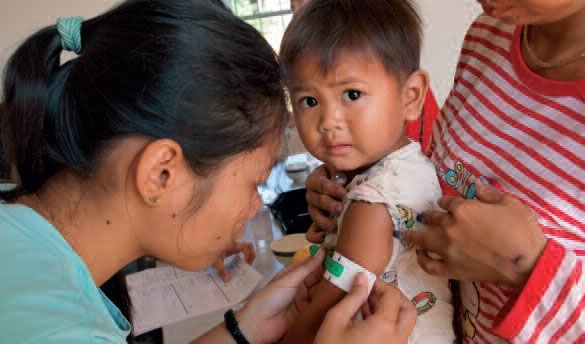Using Mid-Upper Arm Circumference to end treatment of Severe Acute Malnutrition leads to higher weight gains in the most malnourished children
 Nancy M Dale et al.
Nancy M Dale et al.
PLOS One, February 2013, Volume 8, Issue 2
The UN Joint Statement on Community-based Management of Acute Malnutrition (CMAM) (2009) recommends that children admitted to therapeutic feeding programmes on MUAC < 115mm, should be discharged after a 15-20% weight gain. When this recommendation is followed, the most severely malnourished children receive a shorter treatment compared to children that are less severely malnourished.
MSF Switzerland conducted a study using MUAC as both admission and discharge criteria in an emergency nutrition programme in Gedaref, North Sudan to see whether it eliminates the effect of shorter treatment duration in most severely malnourished children.
The programme treated children aged 6 to 59 months with MUAC < 115 mm and/or mild oedema. Children with good appetite and no severe medical complications were admitted to the outpatient therapeutic programme (OTP). Children requiring stabilization were referred to the nearest inpatient facility.
Based on evidence that there is very low mortality in children with MUAC above 125 mm, discharge criteria for children in the OTP was set at MUAC > 125 mm for two consecutive measurements plus stable weight or continuing weight gain, absence of bilateral oedema for four weeks, clinically well and with good appetite.
Outcomes of the children in the OTP were within SPHERE standards with proportions of cured, defaulter and deaths being 82%, 15% and 1% respectively. The remaining 2% were referred to the main district hospital. The median length of stay of all children was 60 days. Children with lower MUAC at admission had longer durations of treatment. The overall percent weight gain of all children was 21 and the majority of children gained more than 15% of their weight at admission.
This study shows the following:
- Using MUAC as a discharge criteria eliminates the effect of shorter treatment in most severely malnourished children and longer treatment for least severely malnourished, as observed with percent weight gain.
- As a result of the longer treatment, the most severely malnourished children such as those with the lowest MUAC on admission achieve a higher percent weight gain than the recommended 15%.
- The use of MUAC as discharge does not seem to increase the length of stay and thus the cost of the programme, though this may vary in different contexts.
The authors conclude that using a discharge criteria of MUAC > 125 mm is feasible and led to acceptable durations of treatment and weight gains in this setting. They suggest that the validity of this cut-off be confirmed in other settings.

